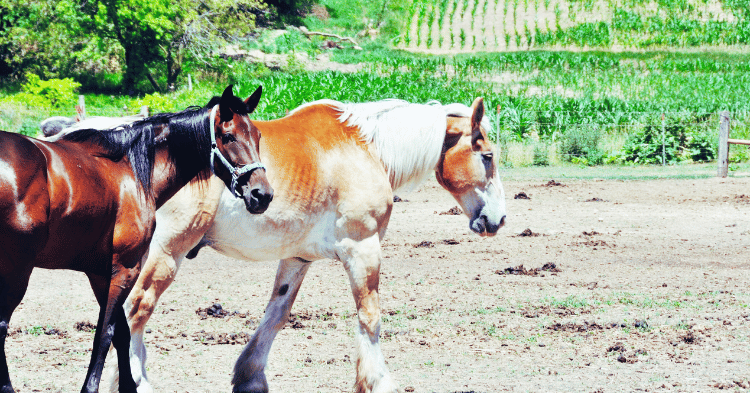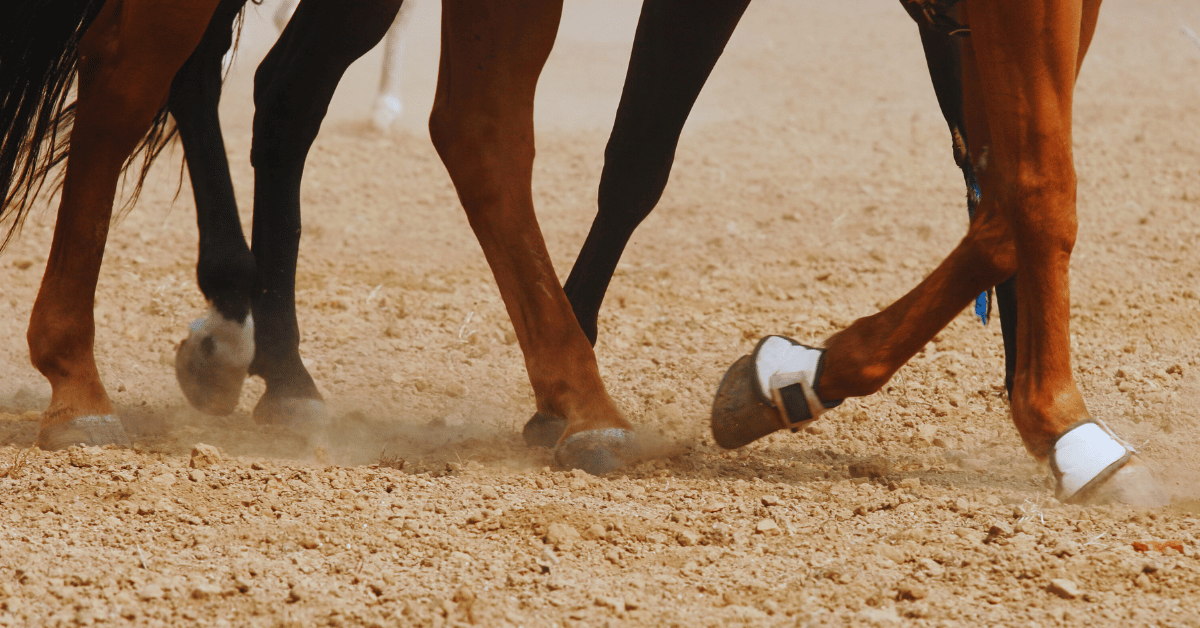Have you ever wondered, can horses walk backwards, and what does it reveal about their movement capabilities? The answer is yes—horses can walk backwards, but it’s not something they do naturally or frequently. Unlike forward movement, which is fluid and instinctive, walking backwards requires conscious effort and coordination, engaging different muscle groups and testing their balance.
This skill is often developed through training, as it’s not commonly used in a horse’s natural behavior. Backward walking can be a sign of a well-trained horse, often used in activities like dressage or trail riding when maneuvering tight spaces.
However, difficulty in walking backwards may indicate physical discomfort, stiffness, or underlying health issues. Observing this movement can provide valuable insights into a horse’s strength, flexibility, and overall well-being. Let’s explore the fascinating biomechanics behind this reverse gear and what it means for equine mobility.
Horse Backing Ability

Natural Backing Behavior
When a horse backs naturally without interference from the rider, they perform a two-beat diagonal gait known as the back. The back has a similar hoof pattern to that of the trot, but in reverse. The footfall pattern for the back might be the right front moving with the left hind and the left front moving with the right hind. Understanding this natural behavior is crucial for assessing whether a horse can walk backwards. As stated by My Horse University, this movement involves a specific coordination of limbs, emphasizing the horse’s innate ability to perform backward locomotion.
Horse Locomotion Abilities
Horses exhibit a variety of natural gaits. These gaits include walking, trotting, pacing, and galloping. Each gait serves different practical and physiological purposes:
- Walk: A 4-beat gait where each foot leaves and strikes the ground at different times. With two or three feet always on the ground, it forms a stable triangular base of support. Unlike other gaits, there is no period of suspension where all feet are off the ground.
| Gait | Description | Beats |
|---|---|---|
| Walk | 4-beat gait, each foot strikes at different times | 4 |
| Trot | 2-beat diagonal gait with periods of suspension | 2 |
| Canter | 3-beat gait with a period of suspension | 3 |
| Gallop | Fast, 4-beat gait with a period of suspension | 4 |
| Pace | 2-beat lateral gait | 2 |
Information sourced from Montana State University Extension.
Under domestication, horses have also acquired additional gaits such as the slow lope, running walk, rack, stepping pace, and fox trot. These provide further insight into the varied movement capabilities of horses, making it clear that backward walking is within their natural locomotive abilities. For more intriguing facts about horse capabilities, check out our articles on can horses sweat, can horses eat apples, and can horse see color.
Mechanics of Walking Backward
Understanding the mechanics of how horses walk backward involves analyzing both their skeletal adaptations and muscular functions.
Skeletal Adaptations in Horses
The skeletal structure of horses is adapted to allow for a range of movements, including walking backward. Horses possess a highly flexible spine and strong, yet adaptable, limb joints that support reverse motion. While walking backward isn’t a natural movement for horses, their skeletal frame supports it.
| Skeletal Component | Function |
|---|---|
| Spine | Provides flexibility and support for various movements |
| Limb Joints | Allow for a range of limb movements |
| Pelvic Structure | Supports reverse action with balance |
Horses have to learn the sequence of movements when walking backward, as it is not a default behavior Kenzie Dysli. In natural settings, horses often turn around instead of walking backward. Training can help them learn to move backward over several steps, demonstrating their adaptability beyond conventional forward movement Petsetic.
Muscular Function in Reverse Motion
The muscular system of a horse plays a crucial role in enabling backward movement. Specific muscles, particularly those in the hindquarters and lower back, are engaged more intensely during reverse motion. These muscles are responsible for propelling the horse backward and maintaining balance.
| Muscle Group | Function in Reverse Motion |
|---|---|
| Hindquarters | Provide thrust and balance for backward steps |
| Lower Back | Supports stability and coordination |
For effective reverse motion, horses rely on muscular strength and coordination. Training a horse to walk backward involves conditioning these muscle groups and enhancing their responsiveness Kenzie Dysli. Positive reinforcement techniques can be used to help horses learn this deliberate movement Petsetic.
Backward walking exercises can enhance the human-equine bond, adding a useful skill for various practical applications. It helps in equine therapy and can improve performance in equestrian sports, leveraging the horse’s physical capabilities beyond basic locomotion Kenzie Dysli.
For more information on horse behavior and capabilities, you might be interested in our articles on can horse sleep standing up and can horses cry.
Training Horses to Walk Backwards
Training a horse to walk backwards can be both enjoyable and beneficial. Using the right techniques, owners can improve their horse’s responsiveness, coordination, and overall health.
Positive Reinforcement Techniques
Positive reinforcement is a powerful method for training horses to walk backwards. It involves rewarding the horse whenever it performs the desired action. According to Petsetic, this method enhances the human-equine bond and showcases the horse’s intelligence.
- Start with Basic Commands: Begin by establishing verbal commands and physical cues. Use simple words like “back” while gently applying pressure on the horse’s chest.
- Use Rewards: Offer treats, pats, or verbal praise when the horse steps backwards. This encourages the behavior you want to reinforce.
- Consistency is Key: Train in short sessions regularly. Consistency helps the horse understand and remember the commands more effectively.
- Use a Target Stick: For some horses, following a target can simplify training. Use a stick and reward the horse for moving backward towards it.
Benefits of Backward Walking Exercises
Incorporating backward walking into a horse’s routine offers several health and training benefits. As noted by Kenzie Dysli, this exercise can be a great gymnastic activity. However, it should never be used as a form of punishment.
| Benefit | Description |
|---|---|
| Improved Responsiveness | Backward walking checks the horse’s responsiveness to aids, enhancing communication with the handler or rider. |
| Enhanced Balance | Promotes balance and coordination, crucial for disciplines like dressage and western riding. |
| Strengthened Hindquarters | Encourages the horse to place weight on its hindquarters, essential for building strength and efficiency (Kenzie Dysli). |
| Gymnastic Training | Backward walking serves as a beneficial gymnastic exercise, promoting overall physical health. |
| Mental Stimulation | Keeps the horse mentally engaged, preventing boredom and enhancing their overall well-being. |
Implementing backward walking exercises not only benefits the horse’s physical health but also supports better performance in various equestrian sports. For more information on managing your horse’s health and capabilities, check out related topics like can horse sweat, can horses cry, and can horses grow mustaches.
Practical Applications
Equine Therapy Benefits
The ability of horses to walk backward has significant benefits in equine therapy. It helps improve coordination and balance, which are crucial for rehabilitative purposes. Backward walking exercises can address physical asymmetries by engaging different muscle groups, potentially aiding in muscle development and strengthening. For individuals participating in therapeutic riding, such exercises can enhance motor skills and proprioception, thereby contributing to effective therapy sessions.
Equestrian Sports Performance
In the realm of equestrian sports, backward walking exercises play a vital role in improving a horse’s overall performance. This exercise tests the horse’s responsiveness to aids and enhances their balance and coordination. Riders emphasize that backward walking exercises should be smooth, controlled, and feel like moving forward in the opposite direction (Kenzie Dysli).
| Discipline | Purpose of Backward Walking |
|---|---|
| Dressage | Improves balance, coordination, and responsiveness |
| Western Riding | Essential for maneuvers like spins and rollbacks |
| Reining | Aids in executing precise movements and body control |
Training a horse to walk backward on command is particularly useful for disciplines such as dressage and western riding, where precise movements and responsiveness are critical. Proper training ensures that the backward movement is fluid and correct, minimizing the risk of injury. In certain advanced classes like reining, horses can even perform intricate movements such as galloping or cantering backward, demonstrating high levels of skill and training (Quora).
For more insights on the abilities of horses, explore topics such as can horse see color and can horse sleep standing up.
